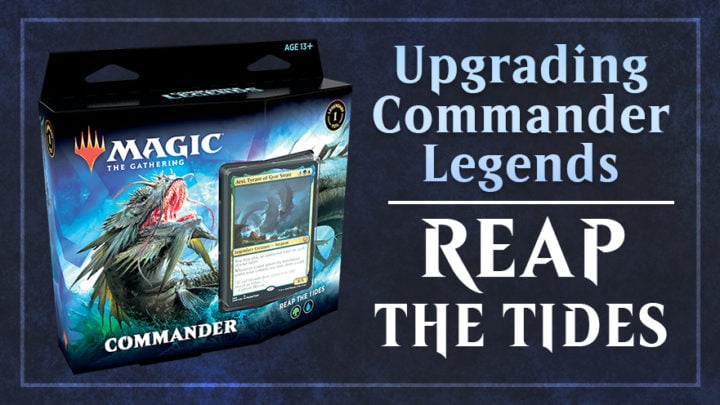The Year of Commander is reaching its peak, and with it come the latest preconstructed decks for Commander Legends. The beauty of these preconstructed decks is their potential; they are great to pick up and play, but they’ve also got a lot of room for upgrading and personalization. Today, I’ll be focusing on the Reap the Tides preconstructed deck, a Simic Ramp deck with a sea creature subtheme.
Reap the Tides: New Commander Cards
Aesi, Tyrant of Gyre Strait might be a brand new commander, but it harkens back to one of the most popular commanders: Tatyova, Benthic Druid. For one more mana, you get a bigger body and the ability to play an extra land every turn, at the loss of the life gain ability. For most Simic ramp decks, this is almost always a better deal.

Stumpsquall Hydra is both a great mana sink and a way to easily grow your commander(s) into a game ending threat. It feels slightly out of place in a deck whose main creature theme is sea beasts, but it’s still a great way to make use of all of those extra land drops you’re making. This would fit nicely into any decks looking to win through commander damage, or that take advantage of +1/+1 counters.

Trench Behemoth is a powerful kraken that can prove extremely difficult to remove. Returning a land to your hand is a paltry sum to pay to protect it, especially when Aesi lets you catch up on your land drops. Its second ability can also wreak havoc on your opponent’s game plan, as forcing a commander to attack into a beefy creature like this will often spell disaster. Both of its abilities can be used to mess with your opponents’ board state and removal, and adding fetch lands into the mix makes this a real nightmare to deal with. It’s expensive to cast, but a great way for larger decks to help leverage the board state to their advantage.
Reap the Tides: Deck Review
Reap the Tides is a great introductory deck for anyone new to Magic, and for any competitive players looking for a change of pace. It’s a nice starting point for anyone interested in green ramp decks, particularly if you also like to slam huge threats and draw cards. Its game plan is reasonably focused, and the scope for upgrading is as vast as it is affordable (as you’ll see below).
In terms of value, Reap the Tides is simply fantastic. For less than $30, it’s a steal; the total value of the cards in the deck come to around $100 at the time of writing. The deck is full of staples like Sol Ring and Beast Within, and well-loved reprints like Ramunap Excavator, Avenger of Zendikar, and Nezahal, Primal Tide make this a great pickup for veteran players looking for a good deal.
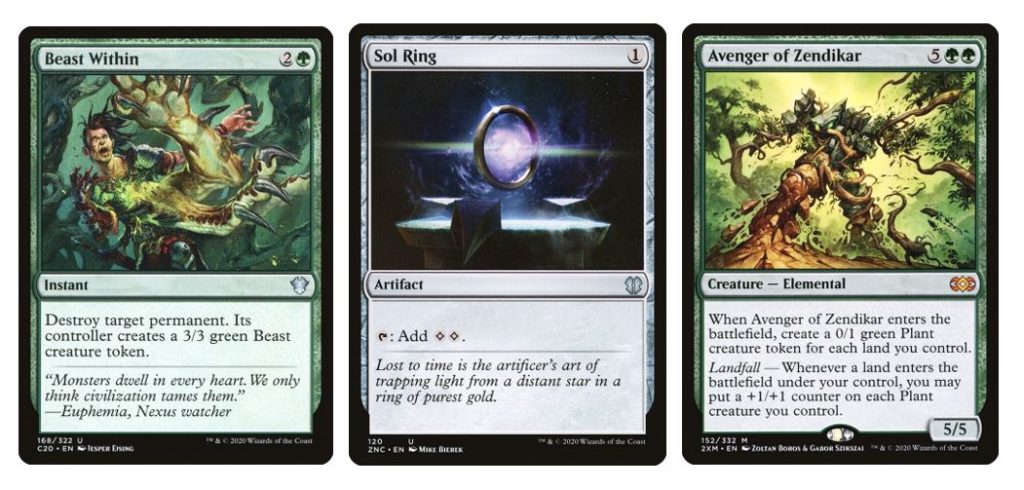
Reap the Tides is currently worth more than any of the preconstructed decks from Commander 2020 and Zendikar Rising. However, its value will change when it’s been available for a while, and will likely drop below the value of the Commander 2020 decks. This is because this deck doesn’t have any highly sought-after original cards, like Fierce Guardianship in Timeless Wisdom (C20).
Compared to the power of the rest of the preconstructed decks from this year, Reap the Tides lies somewhere in the middle. In terms of power, I’d put it slightly below the Commander 2020 decks, but there isn’t much disparity between them. The Zendikar Rising preconstructed decks are reasonably lower power level by comparison, though all of these decks could play well together out of the box.
Upgrading Reap the Tides
Right out of the box, Reap the Tides has a reasonably straightforward game plan. It’s looking to play Aesi quickly, ramp quickly while controlling the board, then play huge sea beasts to end the game. The key cards for these strategies are:
- Aesi, Tyrant of Gyre Strait is our key value engine;
- Avenger of Zendikar and Rampaging Baloths for board presence;
- Scourge of Fleets and Slinn Voda, the Rising Deep for board control;
- Molimo, Maro-Sorcerer and Stormtide Leviathan to punch through for lethal.
These are all extremely effective at their job, and are well-loved by many players. The deck is reasonably well set up to support them; it’s full of impressive land ramp, card draw, and protection spells, though there are certainly a few slots that could be better utilized to make the deck feel smoother.
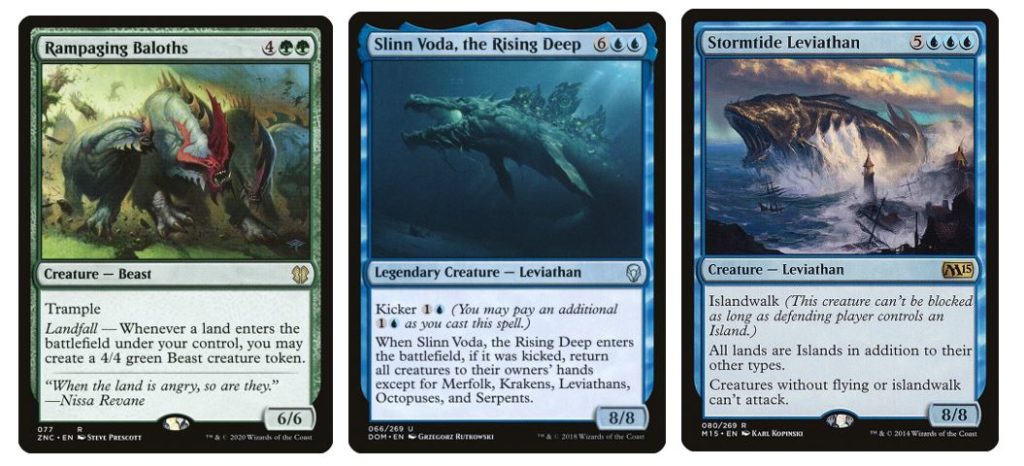
One of the most effective ways to improve any deck is to narrow its focus down to a few key strategies and remove anything that doesn’t really support these game plans. The best way to do this with most commanders is to build around their abilities, and Aesi is no different. Aesi lets you play extra lands and rewards you for doing so, and they act as the deck’s primary value engine.
In order to tighten up the deck, I’m focusing on two main strategies: Ramp and Landfall. The deck already has some excellent landfall cards like Avenger of Zendikar, and there are many more that will help you stack up rewards for making your land drops. As the deck excels at putting lands into play, cards that get better with more lands in play are another fantastic addition. But to make room for these upgrades, we’ll have to make some cuts.
Ironically, I think the preconstructed deck is slightly too land-heavy as-is. Even land-based ramp decks like this would usually run no more than 40-42 lands, and that’s including utility lands. I know it feels strange to remove lands from a deck, but here I believe it to be the right call. That gives us more room for more fun spells!
Additionally, I’m removing many of the lands that enter tapped, as playing on curve is very important in the early game. Green decks are also quite consistent when it comes to fixing, thanks to all the ramp and land tutors available to them, so replacing them with basics and utility lands will work fine.
The sea creatures in the deck are thematically awesome, but they lack a lot of power and synergy that other cards can easily give us. I’ll be keeping some of the more flashy powerhouses like Stormtide Leviathan, as they can still end games in no time. Similarly, the cards that add +1/+1 counters don’t really contribute much to the deck, so I’m swapping them out for more flexible and impressive options.
Landfall
The most impressive strategy right out of the box is Landfall. Rampaging Baloths and Avenger of Zendikar are format all-stars, and for good reason: they’re efficient, powerful, and reward you just for playing the game. It would be wise to lean harder into this as your main strategy; Aesi enables far more land drops than most Tatyova builds ever could, so taking advantage of that is key to a successful build.

The most expensive part of this upgrade is Roil Elemental, but it’s easily one of the most powerful Landfall payoffs. Just one or two turns of ramping with this on board will completely decimate any advantage your opponents have, making it a must-answer threat.
Oran-Rief Hydra is another great choice for the deck, capable of growing to astronomical proportions and threatening to deal some serious damage. Even if it does get killed quickly, that’s one less removal spell being pointed at Aesi!

The final main Landfall card is Zendikar’s Roil, and there’s actually a little hidden combo here. Risen Reef’s ability triggers when Elementals enter the battlefield, and Zendikar’s Roil creates Elementals on Landfall. So as long as you’re hitting lands with Risen Reef’s triggers, you’re making more tokens (and drawing more cards with Aesi)! This is a simple way to build a threatening board out of nowhere, and will command respect from unsuspecting opponents.
Ramp & Lands Matter
It’s no surprise that this deck is exceptional at putting lands onto the battlefield, but there are ways to take advantage by having lands on board, too.
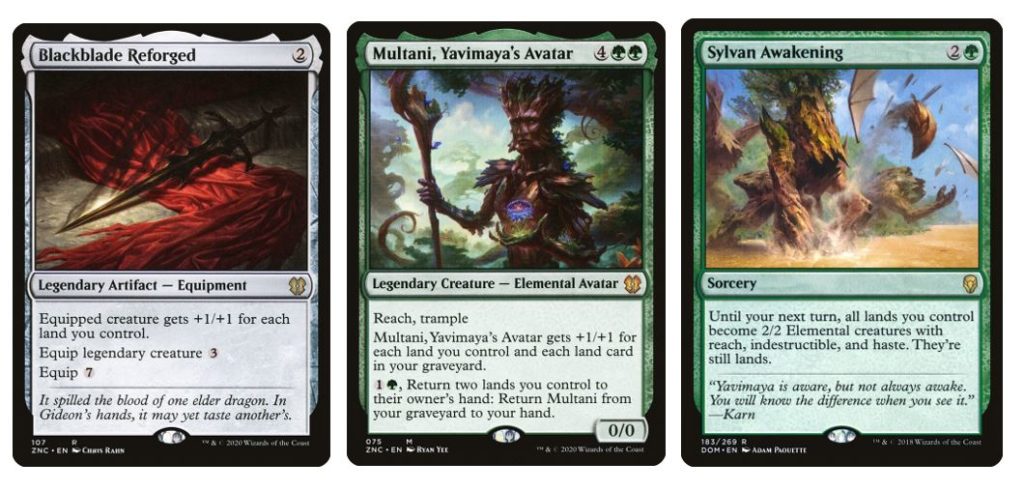
Blackblade Reforged is one of the best upgrades for this deck, effortlessly turning one of your threats into a one-hit kill. Strapping this to Stormtide Leviathan is a death sentence, and dealing lethal commander damage in one hit isn’t unusual, either.
Multani, Yavimaya’s Avatar is extremely impressive here, and a direct upgrade from Molimo, Maro-Sorcerer. They’re big and splashy, but also dangerously resilient; the only way to remove Multani permanently is to exile them, and the cost to recur them is almost completely mitigated by Aesi’s abilities. They also wear Blackblade beautifully!
Finally, Sylvan Awakening is perhaps the most literal way to “win with your lands.” It thankfully gives your lands indestructible, which really minimizes the risk in animating your lands. They also gain reach until your next turn, so you could use the card defensively if absolutely necessary.
Value Engines

Every deck needs some value, and Aesi, Tyrant of Gyre Strait is one of the best value engines available. Tatyova, Benthic Druid is effectively a second copy of your general (and doesn’t get bounced by Slinn Voda!), and Tireless Tracker is incredible as a tertiary engine.
In fact, there are even value engines built into your instants and lands! You can loop a counterspell every turn with Mystic Sanctuary and Deprive, even redrawing the spell immediately with Aesi or Tatyova on board. Similarly, Tragic Lesson can repeatedly loop itself with Mystic Sanctuary, and Kefnet the Mindful is both a value generator and an excellent attacker (especially when wielding a certain sword).
Removal
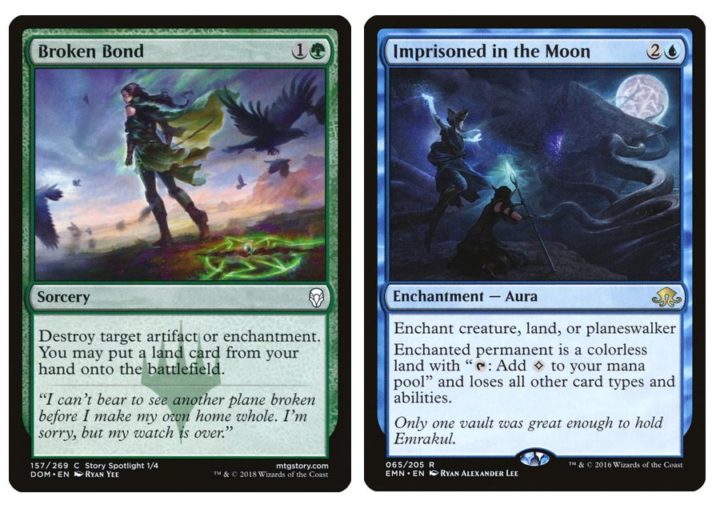
The removal suite in the preconstructed deck is surprisingly reasonable, especially given the colors involved. Broken Bond is the main new addition; it doesn’t look like it’s much better than a Naturalize, but when you destroy a permanent, ramp, and draw a card with it for the first time, you’ll see the appeal. You could add more removal like Imprisoned in the Moon or Reality Shift to suit your taste, though they often require a critical mass of land-centric cards to help keep the engines running.
Utility Lands
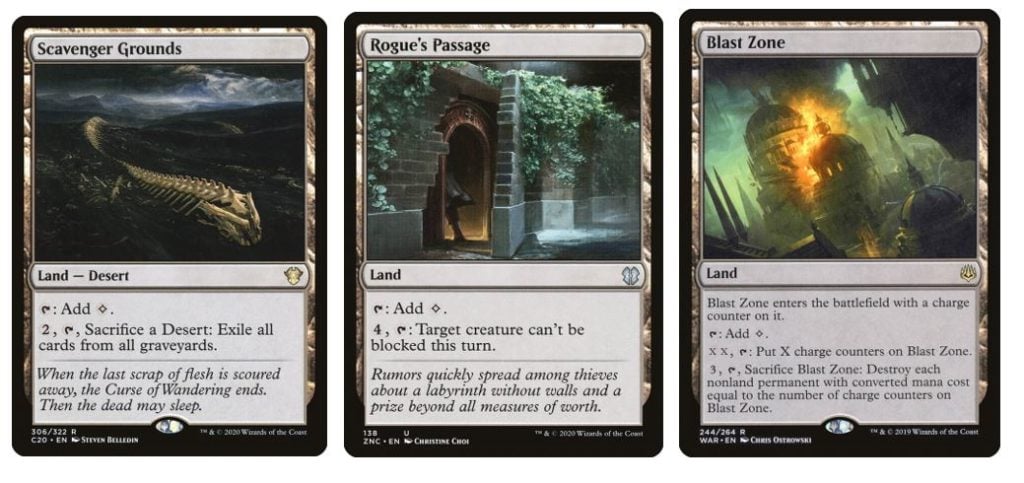
As Aesi allows you to make an extra land drop per turn, you’re less concerned about fetching lands directly into play when the serpent is on the field. This lets you run a small land tutor package in the form of Expedition Map and Nylea’s Intervention. You can use your mana base as a toolbox, giving you specific answers to a multitude of problems. You have Scavenger Grounds as graveyard hate, Rogue’s Passage to slip past opponents’ defenses, Blast Zone for removal, and Mystic Sanctuary to loop spells like Deprive. There are many other tools in your lands, including combo pieces…
Combos
Even the best games can occasionally drag on, especially with monstrous value decks like this one. It’s a good idea to include some form of combo to be able to finish games in a timely manner, even if only as a backup win condition. This upgrade includes the Retreat to Coralhelm combo, which is a popular choice for any land-based deck in green and blue, thanks to individual pieces that work perfectly well separately.
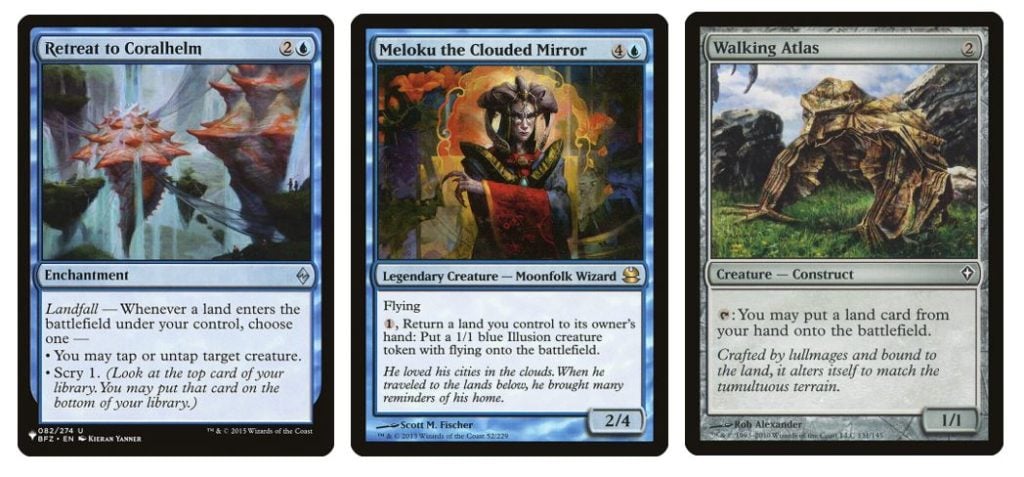
The combo itself is fairly straightforward: Let’s say you have Retreat to Coralhelm and Meloku the Clouded Mirror on the battlefield, with what I call a “land summoner” — creatures that tap to put a land from your hand onto the battlefield. You tap a land to activate Meloku’s ability and make a 1/1 Illusion, then tap your land summoner (let’s say Walking Atlas) to replay the land. This triggers Retreat to Coralhelm and untaps Walking Atlas. You’re back at the start of this loop, but you now have an extra token. You can repeat this as many times as you like to create an army, and wipe out your opponents.
This isn’t the only combination available, either; there are a number of ways to go infinite, all requiring Retreat to Coralhelm and one of your land summoners. Here are a few other combinations:
- Simic Growth Chamber + Landfall creature = Infinite Landfall triggers
- Trench Behemoth + Radiant Fountain = Infinite life & mana
- Simic Growth Chamber + Aesi = Draw as many cards as you like
The Full Upgrade
Decks like this one tend to have two weaknesses in their construction: inability to close the game in a timely manner, and the potential to deck yourself. This upgrade has plenty of powerful win conditions, but so far, it has no way to protect you from running out of cards. What better way to prevent you from losing the game than by winning instead?
Thassa’s Oracle is an incredibly popular win condition for decks on the more competitive end of the power scale, but those decks tend to be built around it. Oracle is included in the upgrade to help shore up one of the deck’s two weaknesses, while also improving to the other. If you don’t like this or would prefer to avoid this card, you can always run Seasons Past or Clear the Mind to keep your library stocked and the game running.
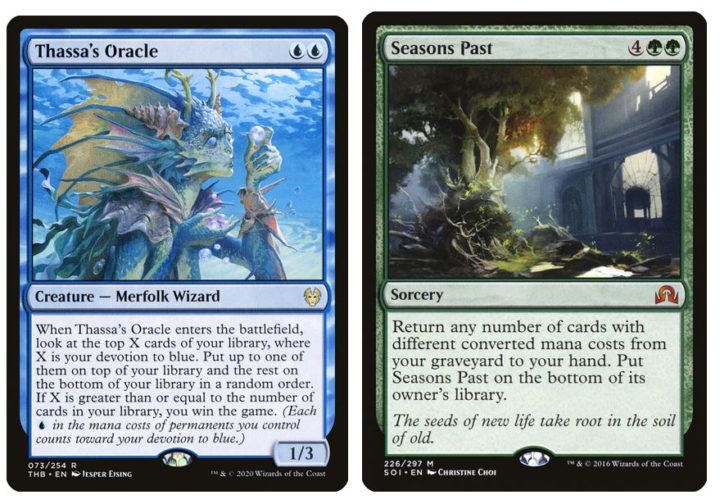
Check out the full upgrade here!
The total cost of this upgrade is approximately $50-60, which is a nice middle ground between affordability and higher power. Both the original preconstructed deck and every piece of this upgrade are available now at Card Kingdom — you can even order them together and have it all arrive at once, for a deck that’s as powerful as it is convenient to buy!
Whether you buy the full upgrade, just the preconstructed deck, or some unique upgrades of your own, be sure to show off your awesome new cards to us on Twitter!

Scott is an Irish content creator and the Head of Budget Magic for the Izzet League. He focuses on affordable decks in Pioneer, Modern, and Pauper, particularly ones that stray from the mainstream. When he’s not writing about his favorite decks, he can be found talking incessantly about them on Twitter and on The Budget Magic Cast.

